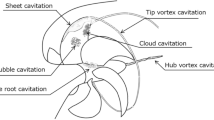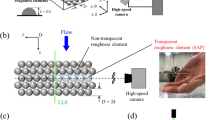Conclusions
-
1.
The force acting on a magnetic particle in a rotating magnetic field due to the formation of eddy currents and a ferromagnetic moment have been calculated.
If the frequency of rotation of the magnetic poles is 100–150 Hz, the eddy currents and the magnetic moment in the particles are small and do not affect the form or mechanism of particle movement.
-
2.
It has been shown that the movement of magnetic particles was related to the interaction between their ferromagnetic moment and the magnetic field of the separator; fluidization of the particles over the drum was caused by the repulsion of the magnetic poles of the particles by the like poles of the magnets. Movement of the particles against the rotation of the magnetic system was due to the nonuniformity of the field at the drum surface and the frictional drag of the particles moving towards the permanent magnets. Particles removed from the magnetic poles of the magnetic system fell into the sphere of action of the scanning magnet.
-
3.
It is desirable to divide magnetic separation into low-frequency and high-frequency separation. Low-frequency separation, with the frequency of rotation of the magnetic system less than 2 secτ, caused the material to move towards the rotating magnetic system. The particles moved against the rotation of the magnetic system during high-frequency separation at more than 4 secτ-1.
-
4.
A transitional zone, where the magnetic particles were actively thrown off the separating surface and the separation process was disrupted existed between these frequencies. The intense rejection of material was due to the change in the direction of movement of the particles. The magnetic particles, torn off the magnetizing poles of the system, encountered the like poles of the scanning system, from which they were repelled and thrown out of the magnetic field.
Similar content being viewed by others
Literature Cited
U. Runolina, “Dry magnetic separation of finely ground magnetite in a rotating magnetic field,” in: Acta Polytechnica Scandinavica, Chemistry Including Metallurgy Series Helsinki, No. 16 (1961).
I. N. Plaksin, V. I. Karmazin, V. F. Olofinskii, et al., in: New Developments in Intense Beneficiation of Finely Disseminated Iron Ores [in Russian], Nedra, Moscow (1964).
L. A. Lomovtsev, N. A. Nesterova, and L. A. Drobchenko, in: Magnetic Beneficiation of Strongly Magnetic Ores [in Russian], Nedra, Moscow (1979).
V. M. Karmazin and V. V. Karmazin, in: Magnetic Methods of Beneficiation [in Russian], Nedra, Moscow (1978).
M. I. Shevlyakov, “Methods of obtaining visual images of the pattern of moving magnetic fields during studies of magnetic separation in scanning fields,” in: Beneficiation of Ores [in Russian], No. 6 (1982).
L. D. Landau and E. M. Lifshits, in: Electrodynamics of Complex Media [in Russian], Nauka, Moscow (1982).
V. V. Rzhevskii and G. Ya. Novik, in: Physical Basis of Rocks [in Russian], Nedra, Moscow (1978).
Additional information
Belgorod. Translated from Fiziko-Tekhnicheskie Problemy Razrabotki Poleznykh Iskopaemykh, No. 1, 88–92, January–February, 1989.
Rights and permissions
About this article
Cite this article
Shevlyakov, M.I., Goridov, S.I. Mechanism of movement of magnetic material in rotating magnetic fields. Soviet Mining Science 25, 73–76 (1989). https://doi.org/10.1007/BF02528434
Received:
Issue Date:
DOI: https://doi.org/10.1007/BF02528434




